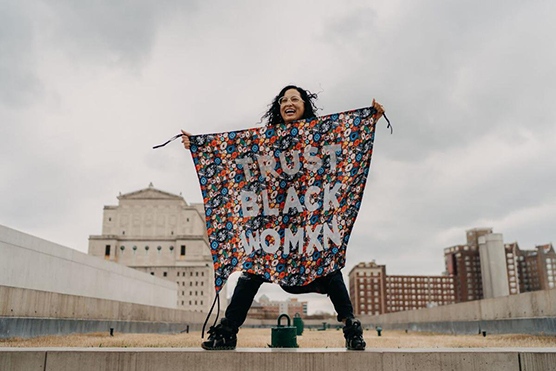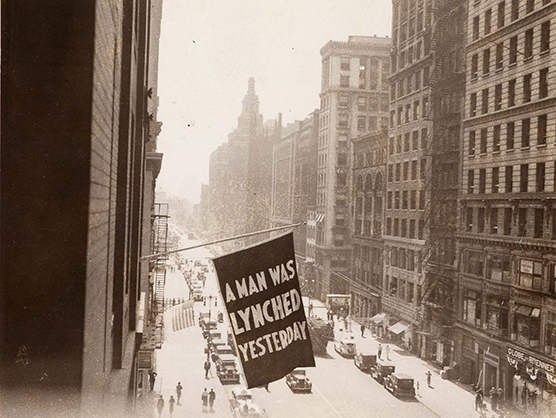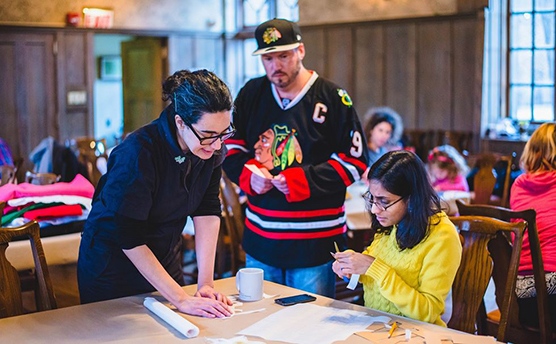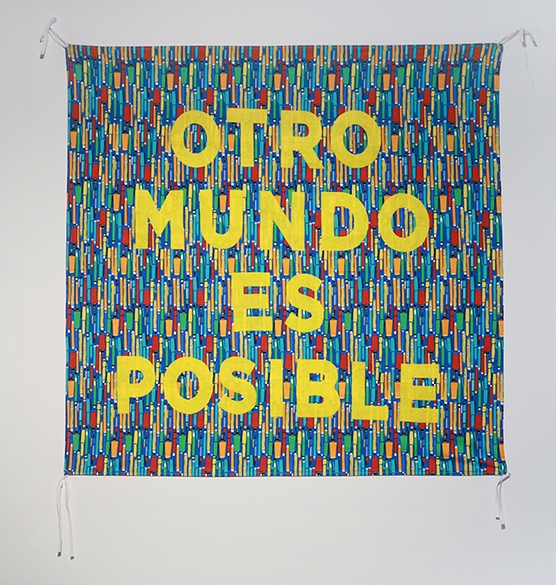
On view in the Case Study Space through January, 2019, HCCC presents a banner from Chicago-based artist and activist Aram Han Sifuentes’ “Protest Banner Lending Library.” Developed in response to the 2016 presidential election, the “Protest Banner Lending Library (PBLL)” provides a safe outlet for individuals to address their concerns about current socio-political issues by organizing protest banner workshops and allowing individuals to check out the banners made from the workshops. HCCC Curator Kathryn Hall interviewed Aram about this project and how she would like to see it move forward.
Kathryn Hall: Historically and internationally, there has been a strong correlation between textile practices and civil rights advocacy. In the early 20th Century, women suffragists sewed protest banners to fight for their right to vote. Around the same time, Gandhi encouraged the people of India to make their own khadi (homespun cloth) as an act of civil disobedience against British colonialism. Following the 2016 U.S. election, many people crocheted Pussy Hats in support of women’s rights. What is the significance of sewing for you, and why have you chosen it as the central process for your Protest Banner Lending Library?
Aram Han Sifuentes: Even though I do not necessarily align myself with some of these histories and movements that you mentioned, I use sewing to protest and fight against dominant culture. I use sewing, because it is linked to my identity politics as an immigrant of color. My mother is a seamstress, and I learned how to sew when I was six years old, the year that we moved to the United States. It was not a choice for me but a necessity to help my parents make a living as new immigrants in this country. I use sewing to create space within dominant culture for immigrants of color, particularly to insert and reclaim traditions of sewing as immigrant traditions and labor.
In addition, fabric banners have advantages to paper posters. First, they are easy to transport, since they can just be folded up. And, secondly, fabric banners can be reused many times. In this way, the project speaks to time and how long we are going to need to be fighting and protesting to create change.



KH: Since 2016, you have generated protest banner lending libraries across the country as a way to serve grassroots efforts. Why do you choose to create libraries that are specific to certain locations, rather than have the lending libraries operate to loan banners on a national scale? Have there been any outcomes that have been unexpected?
AS: National issues are not always local issues, and vice versa. Specificity is really important to me, since any type of generalization and abstraction becomes a violence in the ways in which it makes people and experiences invisible. I aim to make as many fights, protests, and specific concerns as present as possible. In this way, a big part of the PBLL is to become a resource for local activists and protestors. It’s critical that these banners support ongoing local protests.

KH: Where was OTRO MUNDO ES POSIBLE made? Could you speak about your experience working with this community and the relationships that you have developed through the project?
AS: OTRO MUNDO ES POSIBILE was made by my collaborator, Verónica Casado Hernández and me as part of the Chicago PBLL. Chicago is our home base and where the project first began in 2016. We’ve done workshops all over the city and have over 200 banners in the Chicago PBLL, which constantly get checked out and used.
KH: As a community organizer, what are some of the challenges that you face with this project? What would you like to see more of with the project moving forward, and how do you feel arts institutions can be most effective in helping support your work and creating spaces that support marginalized communities?
AS: I don’t think I’m a community organizer. I’d call myself an artist, socially engaged artist, and supporter/facilitator. The biggest challenge with PBLL is keeping up with all that is happening in the world and to create specific slogans that keep up with politics and news. There are new threats taking place every day on our rights and particularly the rights of certain racialized, gendered, and sexualized people.
There is a lot that arts institutions can do to create space for marginalized communities. For one, they need to hire and bring in more women, queer, disabled, POC (people of color) artists at every opportunity. As an immigrant of color, I think a lot about how certain arts institutions are not familiar or welcoming spaces for my people. I’d love to see this be worked on to make art and arts institutions become safe spaces for all.
Protest Banner Workshop
On January 16th, 5:30 – 8:00 PM, join HCCC for a free, banner-making workshop led by Verónica Hernandez as part of Aram Han Sifuentes’ Protest Banner Lending Library. During the workshop, visitors will learn how to create their own banner to share their voices and experiences and contribute to the growing library of handmade banners.
Participants will learn how to cut and attach letters to cloth to create large-scale banners that examine issues such as immigration, citizenship, race, and craft. Attendees are invited back to HCCC the following night, January 17, to continue the discussion about “craftivism” and to display their finished banners at the winter Craft Social event.
There are no fees for this workshop, and all materials for the banners are provided, but registration is required. Learn more and register here.
To learn more about the Protest Banner Lending Library and how to get involved, please visit the website.
About Aram Han Sifuentes
Based in Chicago, Illinois, Aram Han Sifuentes is a fiber, social practice, and performance artist who addresses issues related to immigrant and disenfranchised communities. Sifuentes uses skill sharing, specifically sewing techniques, to create opportunities for individuals to critique social and political inequality and empower one another through advocacy, subversion, and protest. She received her MFA in fiber and material studies from the School of the Art Institute of Chicago and a BA in art and Latin American studies from the University of California, Berkeley. She is currently teaching as an adjunct assistant professor at the School of the Art Institute of Chicago. Sifuentes has received numerous awards. She was the 2016 Smithsonian Artist Research Fellow, a 2016 3Arts Awardee, and a 2017 Sustainable Arts Foundation Awardee. Sifuentes has exhibited her work at the Pulitzer Arts Foundation (St. Louis, MO), Jane Addams Hull-House Museum (Chicago, Illinois), Chicago Cultural Center (Chicago, Illinois), Asian Arts Initiative (Philadelphia, PA), Chung Young Yang Embroidery Museum (Seoul, South Korea), and the Design Museum (London, UK).

